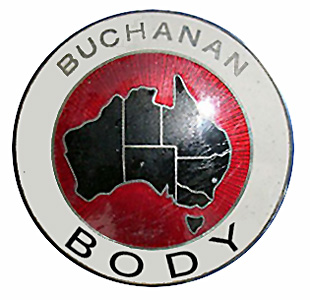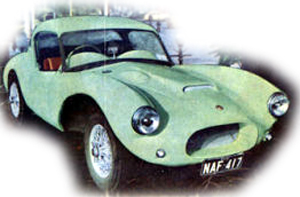|
Great
Australian Sports Cars & Specials 1987 If at first you don't succeed, try and try again. That may well have been Nat Buchanan's maxim for he certainly tried hard again and again to establish a successful Australian sports car. The attempts didn't make him a fortune but he did make quite a few cars, and in so doing made Buchanan one of the best known names in the local specialist sports car industry. It was for good reason that this happened; three good reasons, actually. The first Buchanan made news in the mid-50s with the announcement of a prototype sports car. The Buchanan was an attractively styled coupe with lines right up to date with the latest European fashions. The body was fibreglass and sat on a special chassis using the engine, gearbox and other mechanical parts from the Ford Consul and Zephyr sedans. The prototype created great interest and generated the inevitable claims, rumors and speculation about production-soon-to-follow. But that was as far as it got. The prototype Buchanan coupe was the only one ever completed. However that lone example was known to still be running and in good condition more than 20 years later.
Though Nat Buchanan still dreamed of making his own car, his ambitions
changed somewhat when the Ford-powered coupe project failed to get off the
ground, for it wasn't long after this he decided the time and market were
ripe for a "conversion" sports body.
The immediate success of the Buchanan Body proved the Aston Martin DB3S
might have been made for the job. It was a good looking shape in its own
right, with long racy lines that stamped it as a serious sports car. And
it didn't hurt that Aston Martin's racing reputation was riding high at
that time. There couldn't have been many cars better than the DB3S for a
specialist body to resemble.
Aside from the favoured MGs, the Buchanan Body also went onto many other
cars including Triumph TRs and a variety of homebrewed specials, usually
Holden powered. Some were made for racing but by far the most went on to
the street. Buchanan also offered a special chassis that took Holden
running gear, and later offered a neat hardtop for the body. |
|||
|
|
|||
|
The reason Nat Buchanan didn't continue with the body was that he had his hands full with a difficult and demanding new project; his third (and as time was to tell, his last). There had been rumours, of course, that Buchanan was up to something, yet it still came as a pleasant surprise for enthusiasts when in 1958 first details of the Buchanan Cobra were released. Intended to be a relatively cheap sportster, the Cobra was designed to borrow as many mass-produced mechanical parts as possible and to be manufactured as a complete car. The mechanicals were mostly of Standard 10 origin, including the engine, gearbox (with remote gearshift lever from the Standard Pennant model), leaf-sprung rear axle and the wishbones and coils independent front suspension. Not to forget the seats, steering wheel and other miscellanea. The running gear was carried on a robust ladder-type chassis using box-section main members. Manufactured for Buchanan by Pressed Metal Corp (later involved with the Austin Healey Sprite) the chassis also supported the fibreglass body, which was a thoroughly professional job from nose to tail. The nicely styled shell was more than just a pretty face for it was functional too, and very well finished both outside and within the cockpit. Weather protection, for instance, wasn't an afterthought for the equipment included a proper windscreen, side curtains and a practical soft-top. The interior boasted a fully carpeted floor and a big boot with access from the cockpit as well as the rear lid. The dash panel was thought by some reporters to be a bit plain for there was no tachometer, but the huge unlidded "glove" compartment on the left was welcomed. |




